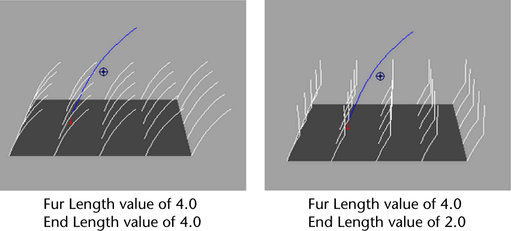The FurCurveAttractors node is created when you attach a hair system to a Fur description. The following attributes are available for this node.
For more information, see Change fur curve attractor set attributes and Fur > Edit Curve Attractor Set.
The following attributes can also be painted using the Paint Fur Attributes Tool, or texture mapped: Radius, Power, Influence, Start Length, End Length, and Threshold Length.
Select the type of curve attractor you want.
Local attraction affects the direction and shape of the fur by the amount the nearest attractor varies from its initial state. The initial state is either the normal (by default) or the starting position of the fur, if Set Start Position To is used (see Set the start position of hair curves to the fur position). This lets you accurately propagate the exact changes in the attractors to the fur, whether those changes are subtle or extreme.
Use this setting to adjust the Radius, Power, Influence, and Length values by a common factor (including mapped values). The default is 1.0. For example:
Threshold Length (0.33) * Global Scale (10) = 3.33
If the length of the fur description was 1.5, it would not be influenced by curve attractors, because the global scale value has made the threshold length 3.33, which is greater than 1.5.
This attribute is only available if you are using Global as the Attractor Model type. Use Power to set how the curve will influence the fur strands. The value you enter is the power to a falloff function that makes fur become less influenced at the base of the fur than at the tip.
0.0—The entire length of the fur is influenced.
1.0—Fur is much less influenced at the base.

Set how much influence the curve will have on the fur. The value you enter linearly increases or decreases the influence over the length of the fur. Use the following attributes as guidelines:
If you are using Global as the Attractor Model type, then you can use a higher value than 1.0 for more influence.

Set the point along the fur, in world units, at which the fur will no longer be influenced. For the best effect, this should be at least as large as the longest fur length. With smaller values the tips of the fur will not be influenced.
If you add Noise Amplitude from the Length section to your fur description, the End Length should be longer than the fur length to account for the extra length created by the noise.

This section lets you set additional attributes. It includes a subsection labeled after every Fur Curve Attractor attribute. Each subsection contains the following additional attributes: